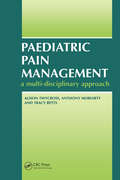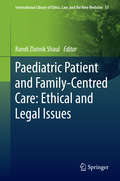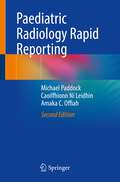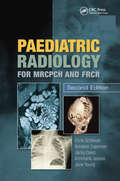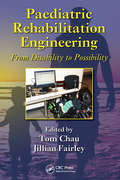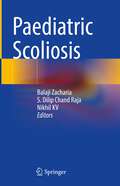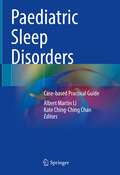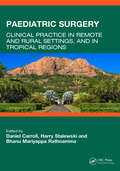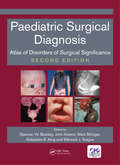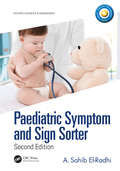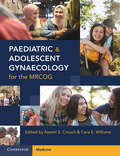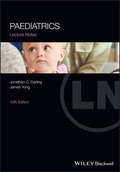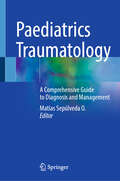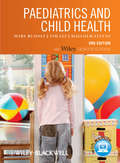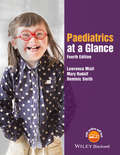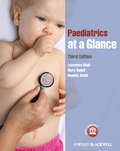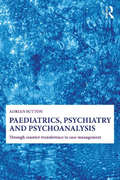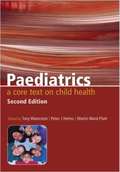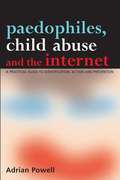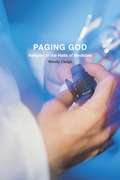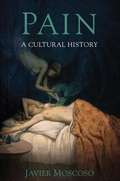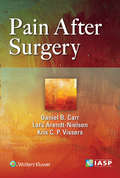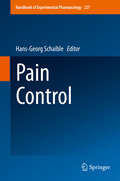- Table View
- List View
Paediatric Pain Management: A Multi-Disciplinary Approach
by Alison Twycross Anthony Moriaty Tracey BettsChildren are still enduring unnecessary pain. This unique book is for all health care professionals who care for children, both in hospitals and in the community, and has contributions from nurses, doctors and clinical psychologists. It provides the theoretical knowledge required to manage acute and chronic paediatric pain, and discusses both drug and non-drug methods of pain relief. The information is presented in an accessible manner to enable readers to apply it in their daily clinical practice.
Paediatric Patient and Family-Centred Care: Ethical and Legal Issues
by Randi Zlotnik ShaulThis book provides the reader with a theoretical and practical understanding of two health care delivery models: the patient/child centred care and family-centred care. Both are fundamental to caring for children in healthcare organizations. The authors address their application in a variety of paediatric healthcare contexts, as well as an understanding of legal and ethical issues they raise. Each model is increasingly pursued as a vehicle for guiding the delivery of health care in the best interests of children. Such models of health care delivery shape health care policies, programs, facility design, resource allocation decisions and day-to-day interactions among patients, families, physicians and other health care professionals. To maximize the health and ethical benefits these models offer, there must be shared understanding of what the models entail, as well as the ethical and legal synergies and tensions they can create. This book is a valuable resource for paediatricians, nurses, trainees, graduate students, practitioners of ethics and health policy.
Paediatric Radiology Rapid Reporting
by Michael Paddock Amaka C. Offiah Caoilfhionn Ní LeidhinThere is a narrow margin between pass and fail in the notably demanding Rapid Reporting component of the Fellowship of the Royal College of Radiologists (FRCR) Part 2B examination. This book provides readers with a comprehensive evaluation of paediatric radiographs, not only for those preparing for this examination but for all those who report them in their clinical practice. The overriding principle remains the same regardless of background – safe radiographic interpretation. Prospective candidates may have only had limited opportunity to report paediatric imaging, which may have been some time before they attempt the examination. Whilst other resources provide only a limited selection of paediatric radiographs, this book is solely dedicated to improving skill and knowledge in paediatric reporting. This text has been meticulously crafted to bridge any gaps in knowledge, while addressing deficiencies repeatedly identified in the FRCR Part 2B Examiners’ Reports in that “many candidates struggle with interpretation of paediatric imaging—even for common paediatric pathologies” and that “knowledge of normal appearances on paediatric plain images…was particularly poor in the Rapid Reporting”. This new edition has been extensively revised and contains 3 new tests. This unrivalled educational resource now comprises nearly 400 practice paediatric radiographs which is unique to the marketplace. The range of cases, from neonate to adolescent, deliver a sound knowledge of common paediatric fracture patterns and pathologies which enables readers to confidently differentiate between normal and abnormal. The much-lauded explanations accompanying these high-quality imaging tests remain robust and accurate, allowing candidates to maximise their preparation for all facets of the FRCR 2B examination and beyond. Foreword by Professor Derek Roebuck
Paediatric Radiology for MRCPCH and FRCR, Second Edition
by Chris Schelvan; Annabel Copeman; Jacky Davis; Annmarie Jeanes; Jane YoungRadiology plays a fundamental role in the diagnosis and management of childhood diseases. This is reflected in both paediatric and radiology post graduate exams, where candidates are expected to have a working knowledge of paediatric pathology, clinical manifestations and appropriate radiological investigations. Building on the great success of the first edition, Paediatric Radiology for MRCPCH and FRCR retains the popular preexisting structure of the book, but presents an improved variety of clinical cases as well as updated text in-keeping with advances in medical practice and technology. There is more emphasis on cross-sectional imaging, as candidates are increasingly encountering these sophisticated imaging tests in postgraduate exams. Images have been updated, and all the clinical information has been reviewed and revised accordingly.Contains over 100 clinical cases, presented in exam format, with answers overleaf Includes a wide range of common and rare paediatric conditions with supplementary images to illustrate additional points Uses classic examination images, with salient radiological and clinical summaries of each condition - the "hot lists" Carries specific information for paediatricians and radiologists for each case An introductory chapter on the basic concepts of imaging aims to provide the reader with an approach to radiological imaging and an awareness of the different modalities available, with new sections on non-accidental injury and radiation protection.
Paediatric Rehabilitation Engineering: From Disability to Possibility (Rehabilitation Science in Practice Series)
by Tom Chau Jillian FairleyInnovations in paediatric rehabilitation engineering can serve as a springboard to education, psychosocial, social, physical and cognitive development for children and youth with disabilities. Instead of providing an overview of rehabilitation engineering, Paediatric Rehabilitation Engineering focuses on the uniqueness of the paediatric subspecialt
Paediatric Scoliosis
by Balaji Zacharia S. Dilip Chand Raja Nikhil KvThe understanding of Pediatric scoliosis has evolved over decades of research, and significant advancements have been achieved in managing the multiple types of scoliotic deformities. This book provides comprehensive information on etiopathogenesis, evaluation, and management of scoliosis along with the latest technological advances. This book is also an invaluable and practical tool providing critical information on the rationale behind the several classification systems of scoliosis. This book, authored by reputed Indian Spine surgeons and renowned international scoliosis experts, focuses on the current treatment algorithms based on the etiology and natural history of the disease and simplifies the decision-making process in managing scoliosis in children. We have included sections that describe various corrective maneuvers, surgical techniques, expected complications, and tips and tricks to avoid them. This book will serve as an essential guide for all orthopedic and neurosurgery trainees and residents and provides updates for experienced surgeons on recent advancements in surgical techniques.
Paediatric Sleep Disorders: Case-based Practical Guide
by Albert Martin Li Kate Ching-Ching ChanThis book aims to provide readers with updated information on the diagnosis and management of common sleep disorders in children. An overview of sleep physiology and sleep disorders evaluation followed by an in-depth discussion with illustrative case examples of the most frequent sleep disorders encountered in children. A section on sleep disorders in children with neuromuscular and developmental diseases has also been included. Written by members of the Asia Pacific Paediatric Sleep Alliance and experts from the region, this case-based textbook will be a valuable reference for sleep researchers, paediatricians, and child neurologists, as well as those who are interested in this field of medicine.
Paediatric Surgery: Clinical Practice in Remote and Rural Settings, and in Tropical Regions
by Daniel Carroll Harry Stalewski Bhanu Mariyappa RathnammaPaediatric surgeons who practice in areas where medical resources are stretched over wide geographical areas face a number of challenges. This resource provides an easy and useful guide to help readers understand the essentials of paediatric surgery. Using the authors’ own experiences, the text illustrates the different management practices required when dealing with paediatric patients in rural and remote settings. The most frequently encountered fetal, infant and paediatric conditions are reviewed, together with coverage of trauma, burns, urology, thoracic surgery, emergency abdominal surgery, minimally invasive paediatric surgery and problems with external genitalia. This book is intended to be a practical guide for clinicians to the common and important problems seen in paediatric surgery, enabling them to make clinical management plans and ensure effective communication with local teams.
Paediatric Surgical Diagnosis: Atlas of Disorders of Surgical Significance, Second Edition
by Warwick J. Teague Spencer Beasley John Hutson Mark D Stringer Sebastian KingThis second edition of Pediatric Diagnosis is a colour atlas of clinical conditions in pediatric surgery. It provides an illustrated guide to the diagnosis of all common and most rare paediatric surgical conditions. Extensively used for examination preparation, the atlas comprises 1400 photographs of congenital and acquired anomalies. This book offers extensive coverage of all the common, and many of the rare conditions in paediatric surgery.
Paediatric Symptom and Sign Sorter: Second Edition (Pediatric Diagnosis and Management)
by A. Sahib El-RadhiThis book will be a vital tool for all clinicians in the front line when an ill child presents with an acute illness. Experienced paediatricians, postgraduate doctors, primary care physicians, and paediatric nurses will find this a useful refresher, and it will be an invaluable primer for newly trained doctors and students, or those new to the paediatric wards. <P><P>Each chapter here provides an overview of each symptom and sign followed by the most likely underlying causes in an easy-to-use tabular format. Investigative techniques and guidelines follow, ranging from the simple and inexpensive to the more complex, as do Top Tips and Red Flag warnings to note; new to this second edition are concluding summaries of Key Points, as well as an entirely new Endocrine chapter.
Paediatric and Adolescent Gynaecology
by Adam H. Balen Sarah M. Creighton Melanie C. Davies Jane MacDougall Richard Stanhope Adam H. Balen Sarah M. Creighton Melanie C. Davies Jane MacdougallProviding a wide-ranging overview of developmental anomalies, disorders and intersex conditions, this textbook presents the best possible advice and practical recommendations concerning medical intervention. With its multidisciplinary approach to health care, the book will be recommended reading for specialists in paediatric and adolescent gynaecology, reproductive endocrinologists, paediatric and plastic surgeons, and clinical geneticists.
Paediatric and Adolescent Gynaecology for the MRCOG
by Naomi S. Crouch Cara E. WilliamsPaediatric and Adolescent Gynaecology (PAG) is a subspecialty that encompasses a broad spectrum of conditions affecting girls from birth up to adulthood. For younger children, vulval dermatological conditions are frequently seen, whilst the adolescent population will often present with menstrual dysfunction or pelvic pain, with a range of aetiologies. This book, aimed at trainees and consultants in the field and all healthcare professionals working in the multidisciplinary team providing care for girls with gynaecological conditions, offers practical, detailed advice on dealing with this spectrum: including rarer conditions such as disorders of puberty, including precocious puberty, delayed puberty and primary amenorrhoea, differences in sex development and Mullerian duct anomalies. Written by international experts in the field, this book will inform and inspire generations of healthcare professionals working in PAG.
Paediatrics Lecture Notes (Lecture Notes)
by Jonathan C. Darling James YongPaediatrics Lecture Notes covers the core aspects of caring for children in clinical practice, offering concise yet detailed information on examination, emergency care, nutrition, immunisation, infant and adolescent health, and more. Designed for medical students and junior doctors alike, this compact and easy-to-use textbook guides readers through each essential aspect of paediatric care, from normal and abnormal childhood development, to cardiology, gastroenterology and metabolic disorders. Throughout the text, key points, practice questions, treatment guides, learning logs and self-assessment tests help prepare readers for paediatric rotations and clinical examinations. Now in its tenth edition, this classic textbook features new and updated information that reflects changes in practice and recent advances in child and adolescent health. Providing a clear and accessible overview of paediatrics, this invaluable single-volume resource: Presents an overview of paediatrics, including expanded materials on genetics, differential diagnosis, investigation for common presentations, and treatment and management of various conditions Offers real-life advice and practical ways of gaining experience in paediatrics and career development Includes OSCE stations, examination review tips, extended matching questions and additional online learning resources Features an enhanced Symptom Sorter to quickly determine which conditions should feature in differential diagnoses Paediatrics Lecture Notes, Tenth Edition is a must-have guide for medical students and junior doctors in paediatric placements and preparing for clinical examinations.
Paediatrics Traumatology: A Comprehensive Guide to Diagnosis and Management
by Matias Sepulveda O.Traumatic injuries of the musculoskeletal system in paediatric patients require a thorough knowledge of biological characteristics and differences with the adult skeleton to provide an accurate early diagnosis and offer the best possible treatment to avoid complications and sequelae that impact the child's life and future. This book provides an up-to-date review of the main topics in paediatric traumatology, from the biology of cell repair, the injuries, classifications, to the diagnosis and prevention. With contributions from experts in the field, it covers the full spectrum of conditions that can affect children, providing detailed information for clinical care as well as discussion of complications and treatment issues related to trauma. Chapters are divided in three main parts: General information, Upper extremity injuries, Lower extremity injuries, and are illustrated by numerous images of clinical cases and diagrams. Paediatrics Traumatology is a comprehensive and invaluable resource for medical professionals and practitioners specializing in paediatric orthopaedics.
Paediatrics and Child Health (Essentials Ser.)
by Mary Rudolf Tim Lee Malcolm I. LevenePaediatrics and Child Health is the perfect textbook to prepare you for clinical practice - providing a comprehensive and practical guide to paediatric disorders as they present to the practitioner, and grouped together by system for easy navigation. From birth through to adolescence, the emphasis is on common and important paediatric problems. This is the only book that takes each symptom and walks you through history taking and physical examination step-by-step. Each section concludes with characteristics and features of the symptoms covered, allowing you to reach differential diagnoses in a logical, highly-structured way. A unique feature are the videos, accessible via your desktop edition, that accompany the book. Designed to enhance your clinical skills and help you in OSCEs, they show you how to examine children correctly. This third edition has been substantially updated throughout and includes new chapters on cardiac conditions and social paediatrics. Beautifully presented, with many new illustrations and photographs, favourite features such as ‘at a glance’ and ‘clues to the diagnosis’ boxes are back, with new ‘red flag’ boxes to signal the crucial information you need. The self-assessment section allows you to check your knowledge and prepare for paediatrics exams. Paediatrics and Child Health is the perfect resource for a course on paediatrics, and is accompanied by a FREE enhanced Wiley Desktop Edition - the interactive digital version of the book with downloadable text and images, highlighting and note-taking facilities, book-marking, cross-referencing, in-text searching, and linking to references and glossary terms. Paediatrics and Child Health is also supported by fully downloadable figures and illustrations at www.wiley.com/go/rudolf/paediatrics.
Paediatrics at a Glance
by Dominic Smith Lawrence Miall Mary RudolfPaediatrics at a Glance provides an introduction to paediatrics and the problems encountered in child health as they present in primary, community and secondary care, from birth through to adolescence.Each concise chapter diagrammatically summarises the main differential diagnoses for each presenting symptom, with accompanying text which covers important disorders and conditions as well as management information.Updates and new features for this edition include:New chapters on 'Ethical Issues in Paediatrics' and 'Screening and Genetics'Fully updated content on autism and adolescent issuesMost likely or serious diagnoses are indicated using a new quick reference iconA brand new companion website featuring self-assessment questions and further reference web links at www.ataglanceseries.com/paediatrics Paediatrics at a Glance is the ideal companion for anyone about to start a paediatric attachment or module and will appeal to medical students, junior doctors and GP trainees as well as nursing students and other health professionals.
Paediatrics at a Glance (At a Glance #75)
by Dominic Smith Lawrence Miall Mary RudolfPaediatrics at a Glance provides an introduction to paediatrics and the problems encountered in child health as they present in primary, community and secondary care, from birth through to adolescence. Each concise chapter diagrammatically summarises the main differential diagnoses for each presenting symptom, with accompanying text which covers important disorders and conditions as well as management information. Updates and new features for this edition include: New chapters on 'Ethical Issues in Paediatrics' and 'Screening and Genetics' Fully updated content on autism and adolescent issues Most likely or serious diagnoses are indicated using a new quick reference icon A brand new companion website featuring self-assessment questions and further reference web links at www.ataglanceseries.com/paediatrics Paediatrics at a Glance is the ideal companion for anyone about to start a paediatric attachment or module and will appeal to medical students, junior doctors and GP trainees as well as nursing students and other health professionals.
Paediatrics, Psychiatry and Psychoanalysis: Through counter-transference to case management
by Adrian SuttonHow do children and parents shape clinical practice? How can clinicians learn from the impact of their patients upon them? How do we recognise if health care practices are adversely affecting health care? Children's health problems can place enormous strain on both children and their families. Whether symptoms are acute or chronic, assessment and treatment can be confusing and frightening even when the illness itself is not dangerous. Understanding the impact of illness on emotions, relationships and development is an essential part of providing good health care services. For health care professionals it is necessary to understand how their clinical practice affects their patients and how this reciprocal relationship shapes good or bad practice. Introducing key psychoanalytic concepts Adrian Sutton illustrates through detailed clinical studies how psychoanalytic theory can be applied in a health care setting involving children and their families. Paediatrics, Psychiatry and Psychoanalysis specifically describes the impact of the patient on the professional, how conscious and unconscious elements need to be taken into account, and to what extent these can influence practice enhancing diagnostic and therapeutic treatment. Paediatrics, Psychiatry and Psychoanalysis is an exploration of the central importance of the patient-doctor relationship and how the psychodynamics of this relationship are crucial in providing information that can aid treatment. It will be of interest to child mental health professionals – psychoanalysts, psychotherapists, psychiatrists, psychologists, nurses, paediatric practitioners and those working in social welfare and educational settings.
Paediatrics: A Core Text on Child Health, Second Edition
by Tony Waterston Peter Helms Martin Ward-PlattIn times of rapid change experience is no longer a sufficient guide to practice. Taking the principles of evidence-based medicine this is the first guide to evidence-based management. It will help managers and clinicians to make a difference to their organisation. Illustrated with case studies designed for 'the reader in a hurry' the clear layout of this practical guide is based on a questioning approach of Why? When? Where? How? and Who? which demonstrates how to apply the best evidence in decision making and in assessing performance. Obstacles to practising evidence-based management in healthcare are described with explanations of how to overcome them. Health managers and clinicians with managerial responsibilities will find this book an essential guide. Leaders in health service organisations public health doctors and public sector managers will find it of great benefit in their work.
Paedophiles, Child Abuse and the Internet: A Practical Guide to Identification, Action and Prevention (Radcliffe Ser.)
by Adrian PowellThis book explains how and why the Government's healthcare policies and modernisation programme have had and will continue to have a major impact on the lives of individual general medical practitioners. Eminent contributors examine critical features of the modernisation programme including managing demand the application of triage and clinical governance and discuss what patients and doctors can expect in the future and where the health service is going.
Paging God: Religion in the Halls of Medicine
by Wendy CadgeWhile the modern science of medicine often seems nothing short of miraculous, religion still plays an important role in the past and present of many hospitals. When three-quarters of Americans believe that God can cure people who have been given little or no chance of survival by their doctors, how do today's technologically sophisticated health care organizations address spirituality and faith? Through a combination of interviews with nurses, doctors, and chaplains across the United States and close observation of their daily routines, Wendy Cadge takes readers inside major academic medical institutions to explore how today's doctors and hospitals address prayer and other forms of religion and spirituality. From chapels to intensive care units to the morgue, hospital caregivers speak directly in these pages about how religion is part of their daily work in visible and invisible ways. In Paging God: Religion in the Halls of Medicine, Cadge shifts attention away from the ongoing controversy about whether faith and spirituality should play a role in health care and back to the many ways that these powerful forces already function in healthcare today.
Paging God: Religion in the Halls of Medicine
by Wendy CadgeWhile the modern science of medicine often seems nothing short of miraculous, religion still plays an important role in the past and present of many hospitals. When three-quarters of Americans believe that God can cure people who have been given little or no chance of survival by their doctors, how do today’s technologically sophisticated health care organizations address spirituality and faith? Through a combination of interviews with nurses, doctors, and chaplains across the United States and close observation of their daily routines, Wendy Cadge takes readers inside major academic medical institutions to explore how today’s doctors and hospitals address prayer and other forms of religion and spirituality. From chapels to intensive care units to the morgue, hospital caregivers speak directly in these pages about how religion is part of their daily work in visible and invisible ways. In Paging God: Religion in the Halls of Medicine, Cadge shifts attention away from the ongoing controversy about whether faith and spirituality should play a role in health care and back to the many ways that these powerful forces already function in healthcare today.
Pain
by Javier MoscosoPain almost always lacks justification, but it does have a story. The gestures of the virgin martyrs, the mockery that accompanied Don Quixote's misadventures, the concealed penitence that took place inside convents, the little comedies of sexual masochism, the early modern anatomical theatres, the grimaces of anesthetized patients, the conscious pains of nervous disorders or the unconscious pains of mental illness all meet one another in this book. Contrary to the claims of the philosopher Cioran, who asserted that it was impossible to hold a conversation with physical pain, each and every one of these pages advocates for such an encounter and promotes such dialogue. Halfway between history and philosophy, this book deals with the successive (though not progressive) forms in which the experience of pain materializes the artistic, juridical, or scientific modalities that have permitted the cultural understanding of human suffering from the Renaissance to the present day. Representation, sympathy, imitation, but also coherence, trust, or narrativity are but a few of the rhetorical and argumentative recourses that men and women have employed, and continue to use, in order to feel our pain but also in order to express it, and to imbue it with meaning and collective value. "
Pain After Surgery
by Daniel B. CarrPublisher's Note: Products purchased from 3rd Party sellers are not guaranteed by the Publisher for quality, authenticity, or access to any online entitlements included with the product. Pain After Surgery offers an in-depth, comprehensive overview of basic and clinical research in the field. It presents the current knowledge and expertise of top global researchers on changes in central nervous system function accompanying and following surgery, as a model of chronic pain development. It also translates scientific understanding into effective clinical management of acute and persistent pain after surgery, including preoperative interventions to decrease the risk of chronification of postsurgical pain.
Pain Control
by Hans-Georg SchaibleThis volume addresses neuronal pain mechanisms at the peripheral, spinal and supraspinal level which are thought to significantly contribute to pain and which may be the basis for the development of new treatment principles. Chapters on nociceptive mechanisms in the peripheral nociceptive system address the concept of hyperalgesic priming, the role of voltage-gated sodium channels in different inflammatory and neuropathic pain states, the hyperalgesic effects of NGF in different tissues and in inflammatory and neuropathic pain states, and the contribution of proteinase activated receptors (PAR) to the development of pain in several chronic pain conditions. Chapters on nociceptive mechanisms in the spinal cord address the particular role of NO and of glial cell activation in the generation and maintenance of inflammatory and neuropathic pain and it discusses the potential role of local inhibitory interneurons, of the endogenous endocannabinoid system and the importance of non-neuronal immune mechanisms in opioid signaling in the control of pain. Furthermore, it is presented how spinal mechanisms contribute to the expression of peripheral inflammation.
